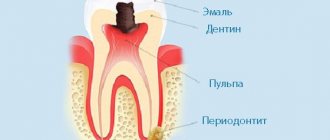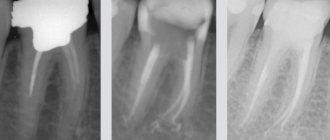Sometimes, after dental treatment, patients go to the dental clinic with a complaint of pain, not knowing that pain after some dental procedures is a normal phenomenon, and only in rare cases does it serve as a warning sign.
What causes pain after dental treatment and what to do in this situation?
Pain after caries treatment
Shallow caries
- After treatment of shallow caries, patients sometimes feel mild pain for several hours; in rare cases, pain can persist for 1-2 weeks. Unpleasant sensations may be aggravated by exposure to cold or hot food, or when biting or pressing on a tooth. The reason is as follows.
After removing the affected tissue from the carious cavity, its walls are treated with a special composition that improves the adhesion of the filling to the tooth. Before applying this composition, the cavity must be dried to a certain extent. If overdrying occurs, the nerve endings in the surface layer of dentin are irritated, which leads to pain. Over time, the dry tissues receive the necessary moisture from the tooth, and the pain disappears.
- The second reason for the occurrence of pain after treatment of superficial caries is the placement of a filling in the cervical part of the tooth, as a result of which the gums or interdental papilla are injured during the dentist’s work. Characterized by a nagging pain, slightly increasing when biting and exposure to cold food. Within a few days, the injured tissues heal, the pain disappears without a trace.
Deep caries
- After treatment of deep caries, pain may occur after the anesthesia wears off (an hour or two after treatment); if a piece of hard food gets on the tooth or if you run a toothpick over the filling. The tooth may also react to cold food: a mild pain occurs that disappears within a few seconds after the irritant ceases.
This is a normal phenomenon and is explained by the fact that the carious cavity was located close to the nerve fibers inside the tooth, and pressure is transmitted to them through the placed filling material. Gradually, the pain decreases and disappears, as a protective layer of dentin forms above the pulp, which separates it from the filling. This is a long process, so discomfort may persist for several months.
- Another reason for pain after tooth treatment may be overheating. This problem is relevant in clinics (usually budget ones) that are not sufficiently equipped with modern equipment, when the area of the tooth is not properly cooled during treatment with a drill. Because of this, hard tissues overheat, which leads to burns of the pulp and pain under the filling.
Pain after pulpitis treatment
When treating pulpitis, the nerve is removed and the canals are cleaned. This is a complex procedure during which special instruments are inserted into the root canals, which can injure tissue near the apex of the root. When treating canals, powerful antiseptics are used, which sometimes irritate nearby tissues. Therefore, after the end of anesthesia, patients almost always feel pain of varying intensity.
When the canal filling procedure is carried out correctly, the pain goes away within 1-7 days, gradually subsiding until it disappears completely.
Pain after periodontitis treatment
The peculiarity of periodontitis is that it often develops asymptomatically, so the tooth may not bother you before treatment, and only after a visit to the dentist begins to hurt. The doctor is not at fault here; the pain that arises is explained by the complexity of the pathological process.
With periodontitis, pathogenic microorganisms move freely from the oral cavity to the root of the tooth, gradually accumulating in the bone tissue around it. After treatment, when the canals are filled, access to the tooth root for bacteria is blocked, the source of infection is localized, and the bacteria remaining in the bone tissue are neutralized by the body’s immune system. If the course of the disease is favorable, pain disappears within two months after treatment.
With weak immunity or other individual characteristics of the body, an inflammatory process occurs. Patients feel aching pain, throbbing, pain when biting and pressing on the tooth. If you experience complaints after periodontitis treatment, you should immediately see a doctor, as additional treatment may be needed.
Types of chronic periodontitis
Studies of the clinical picture of the possible course of chronic periodontitis and morphological signs made it possible to identify the following types:
- Granulating
With this form of the disease, under a microscope, a noticeable thickening can be observed in the apical part of the tooth root. There is a change in the surface of the periodontium, it becomes uneven. Over time, granulation tissue grows, which causes resorption of bone tissue in the area of inflammation. This process is often accompanied by the appearance of purulent foci, which provokes the appearance of fistulas. In some cases, soft tissue adjacent to the site of inflammation undergoes granulation. This causes the formation of granulomas of various types (submucosal, subperiosteal, subcutaneous), after opening which, fistulas appear on the face and oral cavity, and unaesthetic scars appear at the site of their healing.
Patients experiencing granulating inflammation report pain when chewing solid food, aggravated by pressure, as well as periodic exacerbations of painful conditions.
- Granulomatous
One of the forms of periapical inflammation, characterized by the formation of granulation tissue in the area of the root apex. The maturation of this tissue along the periphery provokes the appearance of a fibrous capsule that degenerates into a granuloma. Depending on the structural features, simple, epithelial and cystic granulomas are distinguished. Quite often, this form of the disease occurs as a consequence of granulating inflammation.
The course of the disease can occur according to various scenarios. Sometimes the granuloma grows slowly or does not grow at all. In this case, it usually does not cause any discomfort and is discovered by chance during an X-ray examination.
In other patients, the granuloma may enlarge, most often coinciding with exacerbations of chronic periodontitis, provoking changes in the granuloma tissue.
- Fibrous
It is characterized by the formation of a limited focus of inflammation caused by the spread of fibrous tissue. Most often this occurs after treatment of the forms of periodontitis described above, but sometimes the fibrous form occurs independently.
Often, fibrous inflammation is accompanied by excessive formation of cement, and in some cases, sclerosis of adjacent bone tissue.
An X-ray examination allows you to determine the form of chronic periodontitis. It is very important to correctly differentiate different types of disease, since the effectiveness of treatment directly depends on this.
Other causes of tooth pain after treatment
Pain from an overbite filling
After installing the filling, the dentist polishes it along the bite, but only the patient can tell when biting whether it bothers him or not. Because dental treatment is often performed under anesthesia, numbness in the mouth makes it difficult to determine the height of the filling. After the anesthetic wears off, pain appears when biting when the opposite tooth presses on the over-inflated filling, and it puts pressure on the pulp.
There is a widespread belief that the filling will wear out over time and there is no need to bother the doctor again to correct it. This is wrong, since modern filling materials are incredibly durable and will take years to wear out. Due to malocclusion, patients will experience constant pain and discomfort; over time, the surrounding tooth tissue may become inflamed, which will lead to the need for repeated treatment. The filling grinding procedure is absolutely painless, so don’t delay your visit to the dentist.
Allergy
In rare cases, dental allergies occur - the body’s reaction to an installed filling. Allergic symptoms in the first days after visiting the dentist resemble signs of an inflammatory process: constant pain in the area of the treated tooth, swelling and redness of the gums. Local manifestations of allergies may be accompanied by general symptoms, such as skin rash or itching.
It is impossible to cure an allergy to filling material on your own; if the diagnosis is confirmed, the dentist will replace the installed filling with a less allergenic one.
Causes of pain
If a tooth hurts after treating pulpitis for 2-3 weeks, the pain intensifies, this most likely indicates a complication of therapy. Painful sensations can be either minor or unbearable (causing severe discomfort). Most likely, they indicate that there is an inflammatory process in the gums or an injury has occurred.
Causes of tooth pain after pulpitis therapy
1. Tissue injury. If during treatment the inflamed pulp was removed and the dentist filled the canals, pain may occur for the following reasons:
- periodontal trauma (occurs if the doctor inserts an instrument beyond the apex of the tooth root);
- the effect of an antiseptic solution that is used to treat the canals after pulp removal. The medicine irritates nearby tissues and also leads to a painful syndrome. How long does a tooth hurt after treatment of pulpitis, after exposure to an antiseptic? Painful sensations disappear 1-3 days after therapy on their own. If the pain is very severe, the patient has a low pain threshold, the doctor may prescribe painkillers (it is important to follow the dentist’s recommendations and follow the dosage);
- At the level of the root apex, pulp separation occurred.
2. Complications that are accompanied by severe pain, redness and swelling of the gums, and possibly an increase in body temperature. Important: there are situations when inflammation occurs without any symptoms; only an x-ray can determine it. Alarm bells that indicate a complication and require immediate contact with a specialist:
- Damage/perforation of the root is possible when screwing in a pin or processing the canals with a metal tool. During manipulation, a small hole appears in the root wall or the root breaks. This phenomenon is very often observed in curved, very narrow, and also difficult to pass channels.
The dentist can easily correct this complication; he will close the hole with dental materials; conservative therapy is indicated.
- The filling material got into the periodontal tissue during manipulation.
The doctor decides on re-therapy on an individual basis. If there is not a lot of excess material, and the painful sensations gradually subside, the specialist does not interfere with the natural healing process. A tooth may ache for a couple of months after pulpitis treatment.
What to do in such a situation? Take a wait-and-see attitude. If the pain is unbearable or a lot of material has been removed from the root apex, resection of the apex (surgical intervention) is performed. Excess filling is removed along with the root tip. The void is filled with a special osteoplastic material.
- Allergic reaction to filling material. A person may not be aware of this feature of his body. An allergy is indicated not only by pain in the tooth, but also by swelling of the lip and cheek; these symptoms do not go away over a long period of time.
In this situation, re-filling is carried out, but other materials are used.
- A piece of the instrument broke off and remained in the canal. Dentists emphasize that the process of mechanical treatment of canals is very problematic. This often occurs when the canals are bent.
The doctor does an X-ray diagnosis, and if possible, removes the fragment from the canal. Extraction is quite problematic if a piece of the instrument is stuck at the top of the root. In such a situation, the dentist, based on the individual characteristics of the structure of the dentition and the circumstances, selects the optimal treatment tactics. Leaving a fragment in the canal is strictly prohibited, and it is impossible to fill it properly in this situation! This leads to the infection actively spreading and affecting the jaw bones.
- The canals were not completely sealed. The material simply did not reach the place where the root naturally tapers
If, after treatment of pulpitis, the tooth hurts when pressed, this indicates that inflammation is developing in the emptiness of the dental canal. The infection actively penetrates the periodontal tissue - an abscess forms, and periodontitis occurs. This phenomenon is possible if small voids or pores appear in the channels during manipulation.
In such a situation, it is necessary to unseal the canals and stop the inflammation: rinsing is carried out, the dentist applies antiseptic agents. After some time, the patient comes for an appointment and the canals are filled again. After this manipulation, X-ray diagnostics are performed. The doctor will determine the quality of the filling and will also be able to make sure that there is no periodontal inflammation.
If the top of the canal has not been properly sealed, an operative method of therapy is used - resection (removal). In such a situation, the doctor does not unfill the canals and does not re-fill. After surgical treatment, the resulting space is closed with a special material (it is osteoplastic).
If during therapy the doctor decided to preserve the vitality of the pulp, and the patient is concerned about why the tooth hurts after treating pulpitis, this indicates that the inflammatory process has not been completely eliminated.
Dentists identify the following causes of pain:
- Preparation of caries is fraught with overheating of the tooth, which leads to burns or death of the pulp. That is why measures to preserve the “nerve” may not be successful. This is evidenced by the severe pain that occurs immediately after the anesthesia wears off. In this situation, there is only one way out of this situation - removal of the pulp.
- Polymerization process. Modern composites are subject to shrinkage, which is the cause of pain. The pain is short-lived and lasts for several weeks. In this case, there is no need to take special measures.
- The filling does not match the bite. If the filling is too high, an unpleasant sensation may occur when biting. This problem is resolved very quickly. The doctor grinds the filling. This manipulation takes a few minutes and is painless.
How can you relieve toothache after treatment?
After dental treatment, you need to follow these recommendations:
- Do not drink drinks that are too hot or cold, and food should also be at medium temperature.
- At first, do not chew with a filled tooth.
- Until the pain disappears, eat soft food or grind it so that a hard piece does not accidentally fall on the treated tooth.
- For increasing pain, you can take anti-inflammatory drugs: ibuprofen (Nurofen, MIG 400), ketorolac (Ketanov), nimesulide (Nimesil, Affida Fort).
- If the gums are inflamed, rinse your mouth with a warm infusion of chamomile, a soda-salt solution (one teaspoon of table salt and baking soda per glass of water).
- If threatening symptoms occur, you should consult a doctor.
When do you need to see a doctor urgently?
Acute, throbbing pain after dental treatment, deterioration in general health and an increase in body temperature are a signal for immediate medical attention. The appearance of purulent discharge, severe swelling of the gum mucosa, or various sensitivity disorders in the oral cavity require a thorough examination by a dentist. You should also consult with a specialist if mild, aching pain bothers you for a long time after treatment or occurs when exposed to any provoking factor.
Threatening symptoms
Sometimes, due to various factors, pain does not go away after dental treatment; other symptoms are added to them, which serves as a signal to contact your doctor. You need to see a dentist immediately if:
- body temperature rises;
- acute sharp pain appeared;
- swelling of the tissue around the tooth has developed;
- it is very painful to close your jaws;
- swollen cheek;
- the tooth reacts sharply to hot, cold, sweet or sour foods;
- toothache worsens at night;
- severe pain lasts more than a week after treatment of pulpitis and shallow caries, more than a month after treatment of periodontitis and deep caries.
To understand what the problem is, the doctor will examine the tooth and prescribe additional studies: x-ray diagnostics and electroodontic diagnostics (EDD). An X-ray will show the condition of the tooth roots and the quality of canal filling; EDI will allow you to assess the condition of the pulp. Based on the results of the examination, the dentist will prescribe appropriate treatment.
Relief from pain
If this symptom bothers you greatly or is accompanied by edema or swelling, then contact your dentist. Experienced doctors at the Aurora Star clinic will quickly identify the cause of pain and make every effort to eliminate it. Sometimes this requires simply filling the tooth again (for example, if it was underfilled or overfilled). If complications occur, such as periodontitis, then surgical treatment will be required - an incision to remove pus.
Sometimes pain is a natural phenomenon after treatment for dental diseases. But everyone has their own pain threshold. If this symptom bothers you greatly, your doctor will help you choose the appropriate painkillers. At the Aurora Star clinic you can get rid of the consequences of poor-quality dental treatment, and at the same time, pain. Experienced dentists, modern equipment and a pleasant pricing policy await you.











